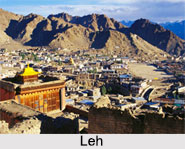 Leh was the capital of the Himalayan kingdom of Ladakh. It is now under the Leh district of Jammu and Kashmir. Leh is the prime tourist attraction among the bikers, because of the wide highways that leads to Manali and Delhi. In ancient era, Leh was the important centre of trade and commerce.
Leh was the capital of the Himalayan kingdom of Ladakh. It is now under the Leh district of Jammu and Kashmir. Leh is the prime tourist attraction among the bikers, because of the wide highways that leads to Manali and Delhi. In ancient era, Leh was the important centre of trade and commerce.
Location of Leh
Leh is covered with an area of 45,110 square kilometers. Leh is dominated by the ruined Leh Palace, the former mansion of the royal family of Ladakh, built in the same style and about the same time as the Potala Palace-the chief residence of the Dalai Lama until the 14th Dalai Lama fled to Dharamsala during the 1959 Tibetan uprising.
Geography of Leh
 Leh is at an altitude of 3524 meters (11,562 ft), and is connected via National Highway 1D to Srinagar in the southwest and to Manali in the south via the Leh-Manali Highway. In 2010, Leh was heavily damaged by the sudden floods caused by a cloud burst.
Leh is at an altitude of 3524 meters (11,562 ft), and is connected via National Highway 1D to Srinagar in the southwest and to Manali in the south via the Leh-Manali Highway. In 2010, Leh was heavily damaged by the sudden floods caused by a cloud burst.
History of Leh
Leh was an important stopover on trade routes along the Indus Valley between Tibet to the east, Kashmir to the west and also between India and China. The main goods carried were salt, grain, pashm or cashmere wool, charas or cannabis resin from the Tarim Basin, indigo, silk yarn and Banaras brocade. Later it became the political centre of Kushana period, Tang Dynasty and Namgyal Dynasty.
Demography of Leh
Leh had a population of 27,513. The males constitute 61% of the population and females 39%, due to a large presence of non-local laborers, traders and government employees.
Education of Leh
Leh has an average literacy rate of 75%, higher than the national average of 59.5%: male literacy is 82%, and female literacy is 65%. In Leh, 9% of the population is under 6 years of age.
Agriculture of Leh
Leh is located at an average elevation of about 3500 meters, which means that only one crop a year can be grown there.
Tourism in Leh
Leh is attracted by the tourists for its natural beauty. This city in Jammu and Kashmir has many tourist attractions like Shanti Stupa, Leh Palace, War Museum, Chamba Temple, Jama Masjid, Gurdwara Pathar Sahib, Zorawar Fort, Stok Palace, Pangong Lake, Tsomoriri Lake, Magnetic Hill, Siachen Glacier, Indus-Zanskar River Sangam, and Nubra Valley of Kashmir.
Visiting Information
Leh is connected with National Highway 1D from Srinagar via Kargil. Leh Kushok Bakula Rimpochee Airport is the only airway medium to connect Delhi, Jammu and Srinagar. There are no railways currently in Ladakh.



















